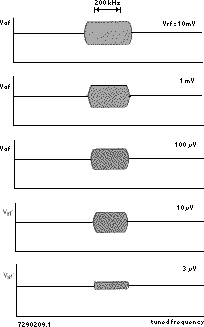A Complete FM Radio on a Chip AN192
AN192
Page 6 of 11
signal is fed to the output. Spurious responses due to the flanks of the demodulator S-curve which occur outside the if. band -f2 to f2 are suppressed because the muting is active. Fast transients of the audio signal due to locking of the loop (A and B), and to loss of lock (C and D) are suppressed in two ways.
Lock and loss of lock transients B and D occur when the if. is greater than f2 and are therefore suppressed because the muting is active. The situation is different during loss of lock transient C because the muting is only active for the last part of the transient. To completely suppress this transient, capacitor Cj in Fig.1 holds the muting control fine positive (muting active) during the short interval whilst the i.f. traverses from -f l to -f2. The same applies for lock transient A during the short interval whilst the i.f. traverses from -f2 to -f l . Since the image response occurs halfway between -f l arid 42, it is also suppressed.

Fig.11 Audio signal of the TDA7000 as a function of the tuned frequency with r.f. input as a parameter. The modulation frequency and amplitude are both constant
Figure 11 shows the audio output ftom the TDA7000 radio as a function of tuned frequency with aerial signal level as a parameter. Compared with the similar diagram for a typical conventional portable radio (Fig.6), there are three important improvements:
- There are, no side responses due to the flanks of the demodulator S-curve. This is due to the action of the correlation muting systern (soft mute) which combines the function of a detuning-dependent muting system with that of a signal-strength-dependent muting system.
- The correct tuning frequency band is wide, even with weak aerial signals. This is due to the a.f.c. action of the FLL which reduces a large variation of aerial input frequency (equivalent to detuning) to a small variation of the if. There is no audio distortion when the radio is slightly detuned
- Although the soft muting system remains operative with low-level aerial signals, there is no degradation of the audio signal under these conditions. This is due to the high gain of the i.f. limiter/amplifier which provides -3 dB limiting of the if. signal with an aerial input level of 1.5&micr0;V. However, the soft muting action does reduce the audio output level with low level aerial signals.
RECEIVER CIRCUITS
Circuits with variable capacitor tuning
The circuit diagram of the complete mono f.m. radio shown in the frontispiece is given in Fig.l. An experimental printed-wiring board layout is given in Fig.12. Special attention has been paid to supply lines and the positioning of large-signal decoupling capacitors.
The functions of the peripheral components of Fig.1 not already described are as follows:
C1:
Determines the time constant required to ensure muting of audio transients due to the operation of the FLL.
C2:
Together with R2 determines the time-constant for audio de-emphasis (e.g. R2C2 = 4µs).
C3:
The output level from the noise generator during muting increases with increasing value of C3. If silent mute is required, C3 can be omitted.
C4:
Capacitor for the FLL filter. It eliminates i.f. harmonics at the output of the f.m. demodulator. It also determines the time-constant for locking the FLL and influences the frequency response.
C5:
Supply decoupling capacitor which must be connected as close as possible to pin 5 of the TDA7000.